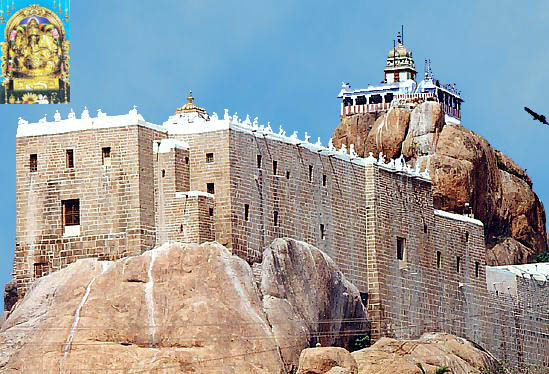Name of the Temple |
- Rock fort Temple
- Thayumānavar Kovil
- Uchchippillaiyār Kovil
|
Location |
- Thiruchirappalli, Tamilnāḍu, South India
|
| How to reach there? |
- By Air : Rockfort temple is located in Thiruchirāppaḷḷi. The nearest airport is Thiruchirāppaḷḷi airport, 13 km north of the temple.
- By Train : Thiruchirāppaḷḷi railway station is 5 km north of Rockfort.
- By Road : Thiruchirāppaḷḷi is well connected to various parts of Thamizh Nāḍu by the National Highway 38 from Thirucchi to Madhurai, 81 from Kāmāchipuram to Sethiathōppu and 83 from Thanjāvūr to Nagapaṭṭinam.
|
Rulers/builders and Time Period |
- 7th Century AD. Dhravidian Architecture (Carving The Mountain).
- There is a rock cut Pallava temple - Lalithānkura Pallaveśhwaram in this hill temple complex with several inscriptions here attributed to Mahendhravarma Pallavan.
- In addition to the Cholas, the Vijayanagar rulers and the Nāyaks of Madhurai have made extensive contributions here.
- The two storied Thāyumānavar temples, built on (in) a hill is a masterpiece of construction. The Chitthirai Manṭapam houses a granite chain with nine loops. The smooth rock was first cut by the Pallavas but it was the Nāyaks of Madhurai who completed both the temples under the Vijayanagara Empire.
- Evidence of Jain occupation around the rock are still exist.
|
Deity/Deities |
- Lord Ganeṣh along with Lord Shiva ( Thāyumānavar / Māthrubhūtheśhwarar) and Ambāḷ (Matturvārkuzhali, Sugandha Kunthalāmbikai)
|
Architecture Style |
- The 83m high Rock Fort is the only outcrop in the otherwise flat land of the city. The rock is one of the oldest in the world-approximately 3.800 million years, which makes it as old as the rocks of Greenland and older than the Himalayas. The sheer abruptness of its rise is a thrill in itself, but the actual centre of attraction is not the fort itself, of which very little remains, but the temple at the summit.
- 344 steps hewn out of rock lead to the top where there are inscriptions dating back to the 3rd century B.C. Hardly anything remains of the ramparts but the Main Guard Gate is still intact.
- The fort played an important part during the Carnātic wars and according to an inscription, mainly contributed to lay the foundations of the British Empire in India.
- At the top of the rock is the Uchipiḷḷaiyār Koil, a temple dedicated to Lord Vināyaka from where one can enjoy a panoramic view of Thiruchirāppaḷḷi. The temple is situated at the top of the rock. The temple is mystic in its nature with an awe-inspiring rock architecture.
- The Ganeśha temple is much smaller with an access through steep steps carved on the rock and provides a stunning view of Trichy, dating over 3 billion years ago, and mythologically this rock is the place where Lord Ganeśha ran from King Vibhīṣhaṇa, after establishing the Ranganāthaswāmi deity in Śhrīrangam.
- Thiruchirāppaḷḷi is considered to be the 6th in the series of Thevāra Sthaḷams in the Chola kingdom located south of the river Kaveri. The temple is mystic in its nature with awe-inspiring rock architecture. The Ganeśha temple is much smaller with an access through steep steps carved on the rock and provides a stunning view of Trichy.
|
Special Reference to Fine Arts |
- A flight of steps leads to the Māthrubhūtheśhwarar of Thāyumānaswāmi temple, dedicated to Lord Śhiva where the lingam is a projection of the rock itself.
- Below the Śhiva temple are the two Pallava cave temples that have beautiful sculptures of the 6th and 7th centuries.
- At the foot of the Rock Fort are a tank and a pavilion which are used during the float festival of the temples. Near the tank is the house where Robert Clive lived when he was in Tiruchirāppaḷḷi and there is an 18th century Church built by Reverend Schwartz of Denmark.
|
Other Special Features |
- Rockfort temple is one of the world famous temple for Religious and its Historical importance in Thiruchirāppaḷḷi, Tamilnāḍu.
- There are two Vināyaka temples at the underneath of the rock Māṇikkavināyagar temple and at the peak of the rock Ucchipiḷḷaiyār temple and in between there is a temple for Lord Śhiva is also known as Thāyumānavar It means the God who turned Mother.
- There is a legend about it. This temple’s presiding deity Lord ‘Thāyumānavar’ (Chevanthināthar) is a self manifest Linga. It is the Fourth biggest Śhivalinga in Tamilnāḍu.
- The Godess here is ‘Mattuvar Kuzhal Ammai’ which means the long haired goddess wearing a garland of flowers imbued with honey. The temple is one among the few temples facing west.
|
References |
- Vibhīṣhaṇa, was the younger brother of the Asura King Rāvaṇa who ruled Lanka. Lord Rāma in the epic of Rāmāyaṇa rescues his wife Sīthā, who was kidnapped and held by Rāvaṇa, with the help of Sugrīva and Hanumān defeated him.
- In this war, the moral and truth-abiding brother of Rāvaṇa , Vibhīṣhaṇa aids Rama in his battle against his brother. Ultimately Rāma wins the war and as a token of love, He gifts Vibhīṣhaṇa a vigraham (idol for worship) of Lord Ranganatha, a form of Vishnu.
- Vibhīṣhaṇa, though he supported Rāma, was basically an Asura, hence the Dhevas (who are arch rivals to Asuras as per Hindhu mythology) wanted to stop this idea of an Asura taking the Lord's supreme form to his Kingdom. They request the help of the remover of obstacles and God of learning, Lord Vināyaka and the Lord accepts the plan. Vibhīṣhaṇa, while on his back to his Kingdom, goes through Trichy and wanted to take his bath in the river Kāveri and do his daily rituals. However, he is perplexed as the deity, once kept in land, can never be removed and has to be in that place as one of the largest temple complexes in the world.
- The Pallavas built the Vināyaka temple and the Thāyumānaswāmi temple, in the rock which Vinayaka uses to escape Vibhīṣhaṇa forever. As a solution, Vibhīṣhaṇa tries to find someone to hold the deity while he was taking bath. He finds Lord Vināyaka under disguise of a cowherd boy. As per the plan, when Vibhīṣhaṇa is fully into water, Vinayaka takes the deity and keeps it firmly in sand, in the banks of Kāveri.
- On seeing this, the angry Vibhīṣhaṇa chases the boy, to punish him and boy keeps running and climbs over the rock near the Kāveri bank. Vibhīṣhaṇa finally reaches the boy and hits him on the fore-head of little boy who then reveals himself to be Vināyaka. Vibhīṣhaṇa immediately apologizes and the Lord gives him his blessings and sends him off to Lanka.
- This is similar to the story of Lord Ganesh in Gokarṇa with Rāvaṇa in the same Rāmāyaṇa period.
- The place on which the Raṅganātha deity was kept was later covered in deep forests, due to disuse and after a very long time, it is discovered when a Chola king chasing a parrot finds the deity accidentally. He then establishes the Raṅganāthaswāmi temple at Srirangam.
|
Special Reference to Performing Arts: |
- Śhrī sugandhikunthaḷāmbikā in the rare rāga kunthaḷa was Dīkṣhithar's tribute to the Goddess of the Rock Fort.
- The holy shrines of Lord Śhiva sung in holy Tamil Compositions are 274 in number.
- Thiruchirāpaḷḷi is one among them. It is on the banks of river Cauvery. Appar and Thirugnyāna sambandhar has sung this deity in Thevāram.
- Lyrics of Ganeśha Pancharathnam Sthothram By Ādhi Śhankarāchārya is a highly revered devotional prayer song of Lord Gaṇapathi.
|
Bibliography |
|















